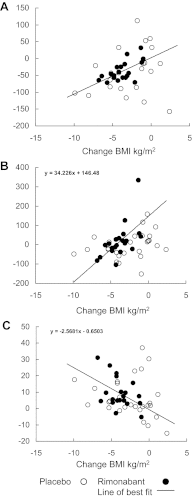Does rimonabant independently affect free fatty acid and glucose metabolism?
- PMID: 22170727
- PMCID: PMC3319222
- DOI: 10.1210/jc.2011-2486
Does rimonabant independently affect free fatty acid and glucose metabolism?
Abstract
Context: Endocannabinoid receptor 1 blockade is proposed to improve metabolic complications of obesity via central and peripheral effects.
Objective: Our objective was to test whether rimonabant improves insulin regulation of free fatty acid and glucose metabolism after controlling for fat loss.
Design: This was a double-blind, placebo-controlled substudy of the visceral fat reduction assessed by computed tomography scan on rimonabant (VICTORIA) trial.
Participants and setting: Sixty-seven abdominally obese, metabolic syndrome volunteers age 35-70 yr participated at academic medical center general clinical research centers.
Intervention: Intervention included a 12-month lifestyle weight management program plus rimonabant 20 mg/d or placebo.
Main outcome measures: Body composition and two-step euglycemic, hyperinsulinemic clamp before and after intervention were performed. Insulin sensitivity was assessed as insulin concentration needed to suppress by 50% palmitate concentration [IC50(palmitate)], flux [IC50(palmitate)f], and hepatic glucose output [IC50(HGO)] and as insulin-stimulated glucose disposal (Δ glucose disappearance per Δ insulin concentration--glucose slope).
Results: Body fat decreased by 4.5±2.9% (SD) in the rimonabant and 1.9±4.5% in the placebo group (P<0.005). The primary [improvement in IC50(palmitate) and IC50(palmitate)f] and secondary [improvement in IC50(HGO) and glucose slope] outcomes were not significantly different between the rimonabant and placebo groups. Post hoc analyses revealed that 1) changes in body mass index (BMI) and IC50(palmitate) were correlated (P=0.005) in the rimonabant group; this relationship was not significantly different from placebo when controlling for greater BMI loss (P=0.5); 2) insulin-regulated glucose disposal improved in both groups (P=0.002) and correlated with changes in BMI.
Conclusions: Improvements observed in insulin regulation of free fatty acid and glucose metabolism with rimonabant treatment in humans was not greater than that predicted by weight loss alone.
Figures


References
-
- Bensaid M, Gary-Bobo M, Esclangon A, Maffrand JP, Le Fur G, Oury-Donat F, Soubrié P. 2003. The cannabinoid CB1 receptor antagonist SR141716 increases Acrp30 mRNA expression in adipose tissue of obese fa/fa rats and in cultured adipocyte cells. Mol Pharmacol 63:908–914 - PubMed
-
- Pagano C, Rossato M, Vettor R. 2008. Endocannabinoids, adipose tissue and lipid metabolism. J Neuroendocrinol 20(Suppl 1):124–129 - PubMed
-
- Herling AW, Kilp S, Elvert R, Haschke G, Kramer W. 2008. Increased energy expenditure contributes more to the body weight-reducing effect of rimonabant than reduced food intake in candy-fed Wistar rats. Endocrinology 149:2557–2566 - PubMed
-
- Jbilo O, Ravinet-Trillou C, Arnone M, Buisson I, Bribes E, Péleraux A, Pénarier G, Soubrié P, Le Fur G, Galiègue S, Casellas P. 2005. The CB1 receptor antagonist rimonabant reverses the diet-induced obesity phenotype through the regulation of lipolysis and energy balance. FASEB J 19:1567–1569 - PubMed

